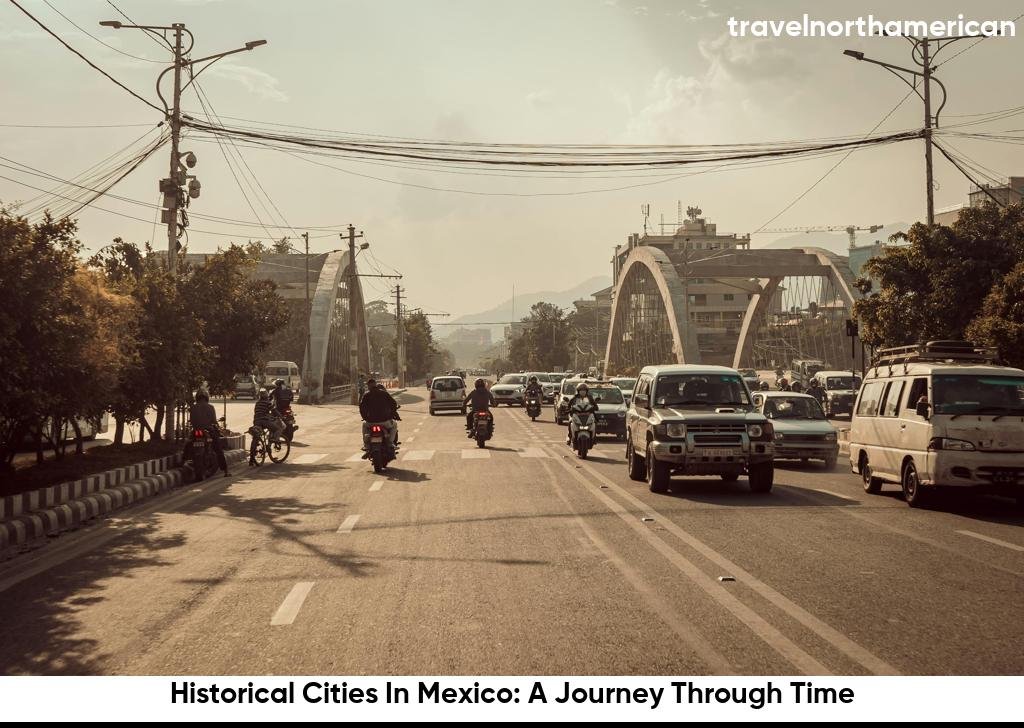Explore the rich tapestry of Mexico’s historical cities, where ancient ruins meet colonial architecture, each telling a unique story of the nation’s vibrant past.
Mexico, a land rich in history and culture, boasts an array of historical cities that echo the stories of ancient civilizations. From the majestic ruins of Teotihuacan to the colonial charm of San Miguel de Allende, each city invites travelers to embark on a journey through time. Vibrant markets, stunning architecture, and fascinating museums reveal the intricate tapestry of Mexico’s past, where indigenous traditions blend seamlessly with Spanish influences. As we explore these captivating locales, we uncover not only the remnants of bygone eras but also the enduring spirit of the Mexican people, whose heritage continues to shape the nation today.

Ancient Mayan Civilization: Exploring the Ruins of Chichen Itza
Chichen Itza stands as one of the most iconic remnants of the ancient Mayan civilization. This UNESCO World Heritage site captivates visitors with its stunning architecture and rich history. As you wander through the ruins, you will find the towering El Castillo pyramid, which demonstrates the Mayans‘ incredible astronomical knowledge. Every structure, from the Great Ball Court to the Temple of the Warriors, tells a story of a once-thriving city filled with cultural significance. Take a moment to imagine the vibrant ceremonies and daily life of the Mayans as you explore this magnificent archaeological wonder, and appreciate the engineering marvels that have stood the test of time.
Colonial Gem: Discovering the Beauty of Guanajuato City
Guanajuato City enchants visitors with its colorful colonial architecture and labyrinthine streets. This UNESCO World Heritage site invites you to immerse yourself in its vibrant atmosphere. Here are some highlights to explore:
- Teatro Juárez: Admire the stunning facade and ornate interior of this historic theater, a testament to the city’s cultural heritage.
- Alhondiga de Granaditas: Visit this emblematic building, which played a crucial role in Mexico‘s struggle for independence.
- Época de Plata: Wander through the streets lined with shops selling exquisite silver jewelry, a nod to Guanajuato’s rich mining history.
- Mercado Hidalgo: Experience local flavors at this bustling market filled with traditional foods and crafts.
As you stroll through Guanajuato’s streets, the combination of history, culture, and breathtaking scenery will leave you enchanted and eager to learn more about this colonial gem.

Aztec Heritage: Uncovering the Secrets of Tenochtitlan
Tenochtitlan, the ancient capital of the Aztec Empire, lies beneath modern-day Mexico City. It was a city of remarkable engineering, culture, and history. Today, archaeologists unveil its secrets, revealing an urban center that thrived with temples, marketplaces, and advanced agricultural practices. The legacy of the Aztecs manifests in the very fabric of Mexico‘s modern identity.
| Key Features of Tenochtitlan | Description |
|---|---|
| Great Temple (Templo Mayor) | A central shrine dedicated to the gods Huitzilopochtli and Tlaloc, showcasing the architectural prowess of the Aztecs. |
| Canals and Causeways | Ingenious waterways facilitated transportation and agriculture, reflecting the city’s ingenuity in adapting to the environment. |
| Chinampas | Floating gardens that increased agricultural yield, demonstrating the advanced agricultural techniques of the Aztecs. |
| Marketplace (Tlatelolco) | A vibrant center of trade where goods from various regions were exchanged, showcasing the economic strength of the empire. |
Magical Towns of Mexico: A Journey into History
Mexico is home to numerous magical towns, known as Pueblos Mágicos, which offer a glimpse into the nation’s rich heritage and cultural diversity. Each town has its own unique history, traditions, and architectural beauty, capturing the essence of Mexican culture. Exploring these towns invites visitors to engage with local artisans, savor traditional cuisines, and participate in vibrant festivals, thus immersing themselves in the storied past of the country.
| Notable Magical Towns | Highlights |
|---|---|
| Taxco | Famous for its silver mines and stunning colonial architecture; a haven for art and craftsmanship. |
| San Miguel de Allende | A UNESCO World Heritage site known for its baroque architecture, vibrant arts scene, and historic significance. |
| Tequila | Home to the world-renowned beverage; offers distillery tours and showcases the production process of tequila. |
| Valle de Bravo | Set around a beautiful lake and surrounded by forested mountains; a perfect retreat for nature lovers and adventure seekers. |

The Enchanting City of Oaxaca: A Cultural Haven
Oaxaca captivates visitors with its rich cultural heritage and stunning architecture. The city is a vibrant tapestry of indigenous traditions and colonial history, where colorful markets and lively festivals thrive. As you wander through the narrow streets, the aroma of traditional Oaxacan cuisine fills the air, inviting you to taste delicacies like mole and tlayudas. Artisans proudly showcase their crafts, from intricate textiles to beautifully crafted pottery, reflecting the region’s deep artistic roots. Oaxaca’s unique blend of culture, history, and natural beauty truly makes it a cultural haven that enchants everyone who visits.
Historic Puebla: A UNESCO World Heritage Site
Puebla, known for its stunning colonial architecture and Talavera pottery, has earned its designation as a UNESCO World Heritage Site. The city’s rich history comes alive in:
- Architectural Wonders: Explore the magnificent Puebla Cathedral and the colorful Puebla tiles that adorn numerous buildings.
- Culinary Delights: Savor the flavors of traditional dishes such as mole poblano and chiles en nogada.
- Cultural Festivals: Experience vibrant celebrations like Cinco de Mayo and the Day of the Dead that reflect the city’s lively spirit.
- Historical Significance: Visit historical sites like the Biblioteca Palafoxiana, one of the oldest libraries in the Americas.
Every corner of Puebla tells a story, making it a must-visit destination for those seeking to immerse themselves in Mexico‘s rich heritage.

Merida: A Blend of Mayan and Spanish Influences
Merida, the vibrant capital of the Yucatan Peninsula, captivates visitors with its rich tapestry of cultural influences that reflect both its Mayan heritage and Spanish colonial history. Founded in 1542 on the ruins of the ancient Mayan city of T’Hó, Merida stands as a testament to the blending of these two distinct civilizations. Today, the city showcases beautiful colonial architecture alongside traditional Mayan elements, creating a unique atmosphere that enchants everyone who walks its streets.
- Architecture: Stroll through the historic center to admire stunning buildings like the Cathedral of Merida, which combines baroque and neoclassical styles with Mayan motifs.
- Cuisine: Savor the local gastronomy, where you can find traditional Mayan dishes such as cochinita pibil and sopa de lima, influenced by Spanish ingredients and cooking techniques.
- Cultural Events: Experience Merida’s lively festivals like Hanal Pixan, which celebrates the Day of the Dead, showcasing a colorful mix of indigenous traditions and Catholic influences.
Hidden Gems: Exploring Lesser-Known Historical Cities
While cities like Mexico City and Guadalajara often steal the spotlight, Mexico is home to numerous lesser-known historical cities that are brimming with charm and rich stories waiting to be uncovered. These hidden gems offer a glimpse into the country’s diverse past and are perfect for travelers looking to escape the crowds.
| City | Highlights | Historical Significance |
|---|---|---|
| San Cristóbal de las Casas | Colorful markets, colonial architecture, and vibrant indigenous culture | Key center for the Zapatista movement; rich in Maya history |
| Guanajuato | Underground tunnels, stunning plazas, and unique mummies | Birthplace of Diego Rivera; notable for its silver mining history |
| Taxco | Beautiful baroque buildings, silver shops, and breathtaking views | Famed for its colonial silver mining; retains its historic charm |
| Puebla | Talavera pottery, Mole Poblano, and stunning churches | Historic site of the Battle of Puebla; rich architectural heritage |

The Rich History of Mexico City: From Aztec Capital to Modern Metropolis
Mexico City boasts a rich tapestry of history that dates back to the Aztec Empire. Originally known as Tenochtitlán, it served as the capital of the Aztec civilization, flourishing between the 14th and 16th centuries. This vibrant city was built on a series of islands in Lake Texcoco, showcasing remarkable engineering feats such as a complex system of canals and causeways. After the Spanish conquest in 1521, Hernán Cortés transformed Tenochtitlán into Mexico City, integrating its stunning architecture with Spanish colonial influences. Today, Mexico City stands as a modern metropolis, blending its ancient roots with contemporary innovations, making it a cultural and historical hub that attracts millions of visitors each year.
Exploring the Ancient Ruins of Teotihuacan: A Window into Mexico’s Past
Teotihuacan, located just northeast of Mexico City, reveals the mysteries of ancient Mesoamerican civilization. This UNESCO World Heritage site is famous for its colossal pyramids, such as the Pyramid of the Sun and the Pyramid of the Moon, which draw explorers and history enthusiasts alike. As you walk along the Avenue of the Dead, you can envision the bustling life that once thrived in this majestic city. The intricate murals and architectural achievements illustrate the advanced society that inhabited this area more than 1,000 years ago.
- Pyramid of the Sun: The largest pyramid in Teotihuacan, standing at approximately 65 meters high, offers breathtaking views from its summit.
- Pyramid of the Moon: Symbolizing the great goddess, this pyramid is part of the complex and showcases impressive ceremonial plazas.
- Avenue of the Dead: This central thoroughfare links the major structures of the city and reflects the layout of Teotihuacan’s urban planning.
- Temple of the Feathered Serpent: A stunning example of Teotihuacan architecture, adorned with intricate stone carvings of Quetzalcoatl, the feathered serpent deity.

